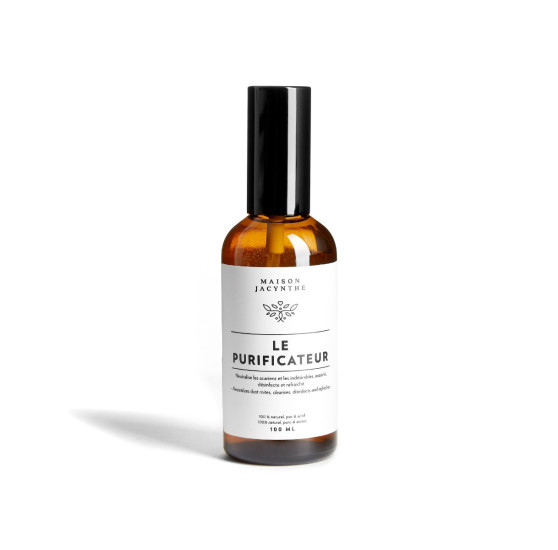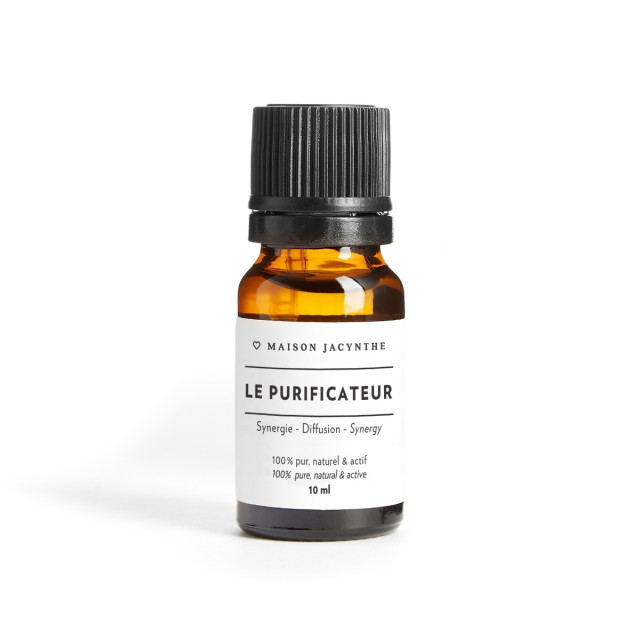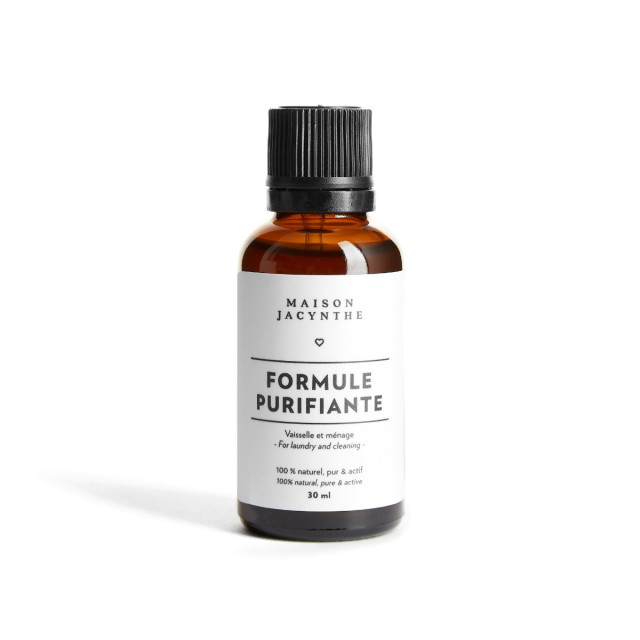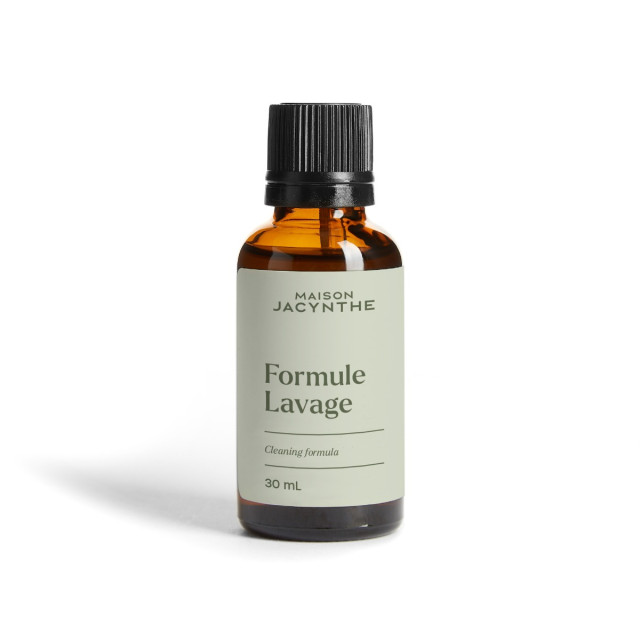Room spray - Le Purificateur
Room spray – Le Purificateur
100 ml
Essential oils - Certified Pure
A well-being fragrance enriched with 15 essential oils sought after in aromatherapy for their purifying, bactericidal and fungicidal properties, Le Purificateur is a precious ally for disinfecting the air, eliminating impurities and bad odors. Do not hesitate to try it to fully enjoy its many benefits!
Its Odor:
The Purifier is appreciated for its aromatic trail of herbs and sparkling freshness, as Rosemary, Thyme, Laurel and the other oils that accompany them give it that much sought-after clean and pure feeling.
Properties:
-
A sanitizing room fragrance, capable of creating a healthy atmosphere in all your living spaces.
-
Made from high quality natural essential oils.
-
This natural and ecological home fragrance replaces synthetic perfumes and chemical sprays without compromise.
-
Easy to use with a convenient spray cap.
-
100% natural & pure
-
No preservatives
Featured Ingredients:
-
Rosemary: this invigorating aromatic plant is valued for its antibacterial and antifungal properties.
-
Thyme: among the most powerful essential oils whose antibacterial properties are well known.
-
Laurel: an essential in aromatherapy for its balancing, soothing and antibacterial properties.
Tips and advice for use:
Directions: practical and easy to use, apply it in small touches at the desired time in your home; or better yet: make it your essential!
Tip: Yes, this star product kills all the unwanted in your home. At home or at the gym, it will become an essential.
Note: before using The Purifier in your home or office, it is recommended to open the windows to air out and specially to reduce the level of indoor pollution.
Ingredients: Alcohol denat (Denatured alcohol), Abies balsamea (Balsam fir) oil, Citrus bergamia (Bergamot) peel oil, Cinnamomum camphora (Japanese laurel) bark oil, Citrus limon (Lemon Petit grain) flower/leaf/stem oil, Litsea cubeba (Yunnan verbena) fruit oil, Rosmarinus officinalis (Rosemary cineole) leaf oil, Cymbopogon martinii (Palmarosa) oil, Mentha piperita (Peppermint) oil, Juniperus communis (Jupiner) fruit oil, Cymbopogon flexuosus (Lemongrass) oil, Melaleuca alternifolia (Tea tree) leaf oil, Thymus vulgaris (Thyme linalool) flower/leaf oil, Mentha arvensis (Cornmint) leaf oil, Perlargonium graveolens (Rose geranium) oil, Ferula galbaniflua (Galbanum) resin oil.
Essential oils and dust mites
Reducing exposure to dust mite allergens in bedding and clothing is likely to be an important environmental control measure for the management and prevention of asthma as well as atopic dermatitis.1 Although it is possible to remove more than 95% of allergens from items by washing in cold or lukewarm water,2 this does not significantly reduce live dust mite populations, because killing dust mites requires washing at 55°C.2 The use of essential oils in bedding and clothing is a good practice.
One study showed that eucalyptus oil, which is a widely available essential oil, can be formulated with a specific kitchen detergent concentrate to form an inexpensive miticidal wash. Its ability to reduce the replenishment of wild populations of live mites found in blankets during normal machine washing by over 95% has been demonstrated. Clove, rosemary, matricaria, and caraway oils, among others, have been shown to have high activity.3
Another study compared the relative acaricidal activity of three essential oils: tea tree, lavender and lemon. The result: the most effective essential oil against mites was tea tree oil; lavender was the second most effective and lemon oil showed activity against mites.4
An experiment is reported in this other study on the comparison of the repellent effect of two essential oils (Matricaria chamomilla, Lavandula angustifolia) against mites, Dermatophagoids farinae and D. pteronyssinus in bed fabric. The essential oils were applied by direct contact at different doses and exposure times. The result of this experiment suggests that two oils have significant repellent activity. Chamomile essential oil in 0.0125 μl/cm2 at 240 minutes caused 93.7% repellent effect and lavender essential oil in 0.05 μl/cm2 at 180 minutes caused 88.9% repellent effect. 5
References
- Harving H, Korsgaard J, Dahl R, Beck HI, Bjerring P. House dust mites and atopic dermatitis. A case-control study on the significance of house dust mites as etiologic allergens in atopic dermatitis. Ann Allergy. 1990 Jul;65(1):25-31. PMID: 2368932.
- McDonald LG, Tovey E. The role of water temperature and laundry procedures in reducing house dust mite populations and allergen content of bedding. J Allergy Clin Immunol. 1992 Oct;90(4 Pt 1):599-608. doi: 10.1016/0091-6749(92)90132-l. PMID: 1401643.
- Saad el-Z, Hussien R, Saher F, Ahmed Z. Acaricidal activities of some essential oils and their monoterpenoidal constituents against house dust mite, Dermatophagoides pteronyssinus (Acari: Pyroglyphidae). J Zhejiang Univ Sci B. 2006 Dec;7(12):957-62. doi: 10.1631/jzus. 2006.B0957. PMID: 17111463; PMCID: PMC1661675.
- Williamson EM, Priestley CM, Burgess IF. An investigation and comparison of the bioactivity of selected essential oils on human lice and house dust mites. Fitoterapia. 2007 Dec;78(7-8):521-5. doi: 10.1016/j.fitote.2007.06.001. Epub 2007 July 3. PMID: 17662541.
- Kang, Myun-Goo & Jee, Cha-Ho. (2012). Repellent Effect of Camomile and Lavender Essential Oils against House Dust Mite in Bed Fabric. Journal of Biomedical Research. 13. 21-26. 10.12729/jbr.2012.13.1.21.
| Format | 100 ml |
|---|---|
| Ingredients | Alcohol denat (Denatured alcohol), Abies balsamea (Balsam fir) oil, Citrus bergamia (Bergamot) peel oil, Cinnamomum camphora (Japanese laurel) bark oil, Citrus limon (Lemon Petit grain) flower/leaf/stem oil, Litsea cubeba (Yunnan verbena) fruit oil, Rosmarinus officinalis (Rosemary cineole) leaf oil, Cymbopogon martinii (Palmarosa) oil, Mentha piperita (Peppermint) oil, Juniperus communis (Jupiner) fruit oil, Cymbopogon flexuosus (Lemongrass) oil, Melaleuca alternifolia (Tea tree) leaf oil, Thymus vulgaris (Thyme linalool) flower/leaf oil, Mentha arvensis (Cornmint) leaf oil, Perlargonium graveolens (Rose geranium) oil, Ferula galbaniflua (Galbanum) resin oil. |






